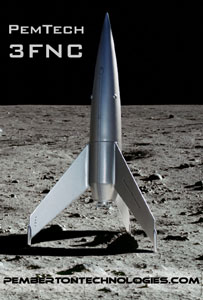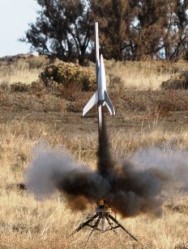| Construction Rating: | starstarstarstarstar |
| Flight Rating: | starstarstarstarstar |
| Overall Rating: | starstarstarstarstar |
| Manufacturer: | Pemberton Technologies  |

Brief:
The 3FNC is the absolute bare minimum of what a rocket can be and still fly... but that's what makes it so cool! It's
a great performer on a variety of mid-power motors, but can also handle a small H if you're feeling particularly
insane. It utilizes a unique "reward blow-by" ejection system to miraculously fit all of the nesessary
hardware into the rocket, and is an interesting departure from the norm to build.
Construction:
My kit came with:
- One 3" Nose Cone
- A 4" long Section of 3" Airframe Tube
- One 29mm MMT Tube
- One Plywood Centering Ring
- One Plywood Baffle Ring

- A Length of Kevlar® Shock Cord
- A Length of Tubular Nylon Shock Cord
- Three Laser-Cut Plywood Fins
- One Wood Dowel (cut up to make fin pods)
- Two Paper Shroud Templates (in case you mess one up)
- Three Carpet Tacs
- One Motor Retention Hook
- One Nomex® Parachute Protector
As the "Destruction Manual" for the 3FNC is quick to point out, "...building this rocket is about as close to scratch-building as... well... scratch-building...". The only conveniences provided for you are pre-cut components. This truly is a "builder's rocket", so modelers who like a good build will have a great time with this kit.
Construction starts with prepping the nose cone for the various bits and pieces that will soon be stuffed into it. The bottom of the NC is cut off to gain access to the inside. Both the outside and inside of the cone are then washed and sanded to ensure good adhesion of paint and epoxy. Approximately 4-5 oz. of nose weight is then added to the nose cone. I put some strips of duct tape over the mass of lead and epoxy to ensure that it stays put.
The next steps involve setting up the motor retention hook. I left this out in favor of masking tape retention.
Next the forward baffle ring is assembled with it's eye-bolt and a length of Kevlar® shock cord.
The BT is then marked and slotted in preparation for the TTW fins.
The Destruction Manual's description of how to install the aft centering ring was confusing to me. It involved a fiberboard ring, masking tape... I just didn't get it. I ended up using one of the fins TTW tabs as a depth guide for the ring and ditching the fiber ring process.
 The
forward baffle assembly is then lowered into the nose cone and tamped down with a wood dowel. The distance from the
shoulder of the NC to the ring is then measured and marked on the outside of the NC. Three tacs are then driven through
the NC in a way that they go over the aft side of the baffle ring, and ensure that everything will stay firmly attached
to each other. It also adds some cool-looking domes on the outside of the NC.
The
forward baffle assembly is then lowered into the nose cone and tamped down with a wood dowel. The distance from the
shoulder of the NC to the ring is then measured and marked on the outside of the NC. Three tacs are then driven through
the NC in a way that they go over the aft side of the baffle ring, and ensure that everything will stay firmly attached
to each other. It also adds some cool-looking domes on the outside of the NC.
Through my own getting-ahead of the destructions, I ended up attaching the fins, then attaching the paper shroud to the aft end of the rocket. You are instructed to do this in the opposite order... oops.
The Nylon part of the shock cord is then epoxied to the side of the motor tube. I added a strip of duct tape around the top of the epoxied section to keep it from peeling back and ripping off.
Then came a part of the build that I found somewhat challenging. To make the cool, retro fin pods, you cut up and then shape a wood dowel. The destructions suggest putting a hand-held drill in a vice, drilling down the center of the dowel, and using the drill lake a lathe to shape the pods with sandpaper. I ended up shaping them with a bench grinder (I'm in the process of acquiring a belt sander, which would've made this a lot easier).
Next was slotting the newly-formed fin pods in preparation to attach them to the fins. I followed the destructions suggestion to use a drill press to drill a series of 1/8" holes in a line. The wood was soft enough that I could then go in and clean it up with a hobby knife. The fin pods were then epoxied to the fins, and I must say that they look cool.
The only modification I made to the kit was to leave out the included launch lug and replace them with rail buttons. Since there isn't room on the inside for them to stick through the airframe, I mounted the buttons on a shaped piece of basswood stock and epoxied that to the airframe.
Finishing:
I painted the nose cone while the rest of the rocket was in assembly. First was a few thick coats of Rustoleum
primer, followed by a 400 grit sanding. Next was a few coats of Rustoleum metallic silver. Unlike other Rustoleum
paints, the silver has a dry time of only 30 minutes, compared to most Rustoleum product's two day drying time.
During the build, the airframe tube had it's spirals filled with Elmer's wood filler. I chose not to use the filler on the fins, as the plywood had a very small grain that I could fill with primer.
Once assembly was complete, the airframe got a few coats of Rustoleum primer, and then was sprayed with the same Rustoleum silver as the NC. On the airframe, however, the paint decided to barely produce any coverage at all, and it took several coats to get anything resembling a good finish. I still don't know why it performed so differently.
Construction Rating: 5 out of 5
Flight:
 The first
flight of my 3FNC came at the Washington Aerospace Club's 2009 Autumn Glare launch. Eager to try out Cesaroni's new
Pro29 line, I flew the 3FNC on an F36 Smoky Sam.
The first
flight of my 3FNC came at the Washington Aerospace Club's 2009 Autumn Glare launch. Eager to try out Cesaroni's new
Pro29 line, I flew the 3FNC on an F36 Smoky Sam.
RockSim predicted a flight to around 600' on this motor. This flight was my first time using a Cesaroni motor, and I was impressed with the ease of assembly and clean up. I can't wait to try out some of their other motors later on.
Upon ignition, my 3FNC was quickly boosted to... well... nowhere near 600'. I estimate it only got to about 200'. Having adjusted the delay for a 600' flight, ejection was quite late, but in time to slow down the rocket. Unfortunately, the cold weather combined with the tight packing of the 'chute resulting in it not fully opening. The NC landed squarely on a rock and broke off the tip. The rest of the rocket was otherwise fine.
The 3FNC flew two more times at the same launch on AeroTech F52Ts. These motors performed more as RockSim had expected them to, both resulting in fast flights to about 1500'. I intend to fly the 3FNC on F40Ws next.
Recovery:
Packing the 'chute for recovery is predictably difficult with the 3FNC, as the entire recovery harness has to fit
into the space between the motor tube and the NC. Unfortunately, I don't have any pictures of how I did this, but I'll
do my best to explain it.
First, I z-folded the shock cord leaving about 6" between the last fold and the parachute. I then lightly taped these folds to the motor tube with masking tape. I then prepped the 'chute in the Nomex® as usual, and placed it on the opposite side of the motor tube as the folded shock cord. I then pushed on the NC and jiggled it until it bottomed out.
On all three flights, the tape released the shock cord without any problems. The 28" 'chute included with the kid is perfect. On one of the flights, the rocket even landed right side up.
Flight Rating: 5 out of 5
Summary:
The 3FNC is a great kit for those looking for a fun project with just as much emphasis on the build as on the flight.
While it presents some unique challenges, that only adds to the fun to be had from this kit. It looks very different
from anything else out there, and I got several comments from people at the launch about it's minimalistic properties.
All in all, it's a great rocket. If you want to add something a little different to your fleet, then I recommend the 3FNC.
Overall Rating: 5 out of 5
Other Reviews
- Pemberton Technologies 3FNC By Drake "Doc" Damerau
Brief: This kit looks very retro. I'm expecting Bugs Bunny and Marvin the Martian to come crawling out of the hatch at any moment. It is the first kit from a brand new company called Pemberton Technologies. Although it's called 3FNC, it's not your ordinary 3 fins and a nose cone rocket. Construction: I don't usually list the components of a kit in a review, but there are so ...
 |
 |
Flights
 |
 |
PEMTECH (December 16, 2006)
 |
 |
R.L.P (January 13, 2006)